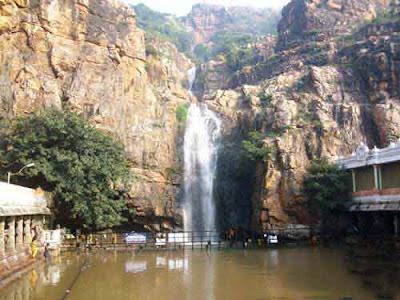Kapileswara Temple in Tirupati – Kapileswara Swamy Temple and Importance of Kapila Teertham in Tirupati
Kapileswara Temple, dedicated Lord Shiva is located at the
foot of Tirumala hills in Tirupati and has a scenic waterfall called Kapila
Tirtham. It is a tradition that before worshipping Lord Venkateswara at the
Tirupati Balaji Temple, devotees must worship Lord Kapileswara. Shiva, as
Kapileswara, is the Kshetra Palaka of Tirumala Hills.
The main deity, Sri Kapileswara Swami, presents Himself in
the form of a magnificent Linga in this cave like rock shrine. The Shivling is
seen facing the Tirumala Hills. There are many other smaller shrines within the
temple complex.
The word Kapila means ‘one who enjoys bliss.’ Lord Shiva is
the epitome of eternal bliss and everlasting enjoyment of spiritual awakening.
Thus, whoever worships Sri Kapileswara, with utmost devotion and dedication,
will attain Kaivalya moksha.
Sri Kapileswara at Kapila Tirtham symbolizes the transcendental
sojourn from mortal world to immortal abode.
Story of Kapileswara Temple in Tirupati
Sage Kapila was in living Patala (one of the netherworlds) in
his hermitage. During Treta Yuga, the 60,000 sons of King Sagara went to this
hermitage in search of their holy cow and found it being tied near Sage’s hut.
Accusing him as a thief they tried to attack Sage Kapila. The sage got angry at
this misdeed and burnt them down into ashes.
Later Kapila came to earth, did penance at the foot of
Tirumala hills, and had the darshan of Lord Shiva who manifested in the form of
a Shivling. This same Shivling is now worshiped as Lord Kapileswara.
History of Kapileswara Temple
The Shivling is worshipped in the temple is very old and no
one knows the real age of it. The present shrine around the Shivling was built
around 11th Century AD.
The first epigraphic reference to this temple belongs to the
period of Chola King Rajendra I (1012 AD to 1044 AD). One of his royal officers
named Brahmarayan Munaiyadarayan had built the shrine.
The last epigraphic record found in this temple belongs to
the reign of Vijayanagara emperor Sadashivaraya.
Architecture of Kapileswara Temple
The temple reflects Chola and Vijayanagara architecture and
contains a pillared verandah, Mukhamandapa, Antarala and Garbhagruha. In the
southern side of the inner shrine, there is a shrine dedicated to Kamakshi
Devi, the consort of Kapileswara.
Other temples inside the complex are of Kumara Swamy,
Ganapati, Venugopala Swamy, Lakshmi Narayana Swamy and Lakshmi Narasimha Swamy.
Apart from these temples, there are few smaller shrines having different Shivlings
and stone images such as Dakshina Murthi, Kaala Bhairava, Shiva-Nataraja etc.
Sandhyavandana Mandapas, a row of pillared corridors, built
around the Kapila Teertham tank are the unique feature of this temple.
All Sacred Teerthams of the World In Kartik Month
Sthala Purana says that during Kartika Masa (November –
December), all the sacred Teerthams of three worlds dwell in Kapila Teertham.
Pinda and Tarpan at Kapila Teertham
Bhavishyottara Purana describes Kapila Teertham as the most sacred
place to offer Pinda and Tarpana for departed elders. The story of Madhava of
Kalahasti town narrated in Bhavishyottara Purana shows the piety of Kapila
Teertham.
Fairs and Festivals
The most important festival observed here is Shivratri
(February – March).
The annual Brahmotsavams is very special to the devotees.
Sri Kapileswara Swami with Mother Goddess Ammavaru is worshipped with great
pomp and splendor. Sri Kapileswara Swami is decked on various Vahanams, and He blesses
the devotees with his grace.
